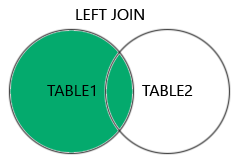SQL Right Join
SQL RIGHT JOIN Keyword
All records from the right table (table 2) and the matched records from the left table (table 1) are returned using the RIGHT JOIN keyword. If there is no match, the outcome is 0 records from the left side.
RIGHT JOIN Syntax
SELECT column_name(s)
FROM table1
RIGHT JOIN table2
ON table1.column_name = table2.column_name;
Note: RIGHT OUTER JOIN is the name given to RIGHT JOIN in certain databases.

Demo Database
We’ll be using the well-known Northwind sample database in this tutorial.
A sample from the “Orders” table is shown below:
| OrderID | CustomerID | EmployeeID | OrderDate | ShipperID |
|---|---|---|---|---|
| 10308 | 2 | 7 | 1996-09-18 | 3 |
| 10309 | 37 | 3 | 1996-09-19 | 1 |
| 10310 | 77 | 8 | 1996-09-20 | 2 |
And a selection from the “Employees” table:
| EmployeeID | LastName | FirstName | BirthDate | Photo |
|---|---|---|---|---|
| 1 | Davolio | Nancy | 12/8/1968 | EmpID1.pic |
| 2 | Fuller | Andrew | 2/19/1952 | EmpID2.pic |
| 3 | Leverling | Janet | 8/30/1963 | EmpID3.pic |
SQL RIGHT JOIN Example
All employees, along with any orders they may have placed, can be obtained by running the following SQL statement:
Example
SELECT Orders.OrderID, Employees.LastName, Employees.FirstName
FROM Orders
RIGHT JOIN Employees ON Orders.EmployeeID = Employees.EmployeeID
ORDER BY Orders.OrderID;
Note: Even in cases when there are no matches in the left table (Orders), the RIGHT JOIN keyword retrieves all records from the right table (Employees).
